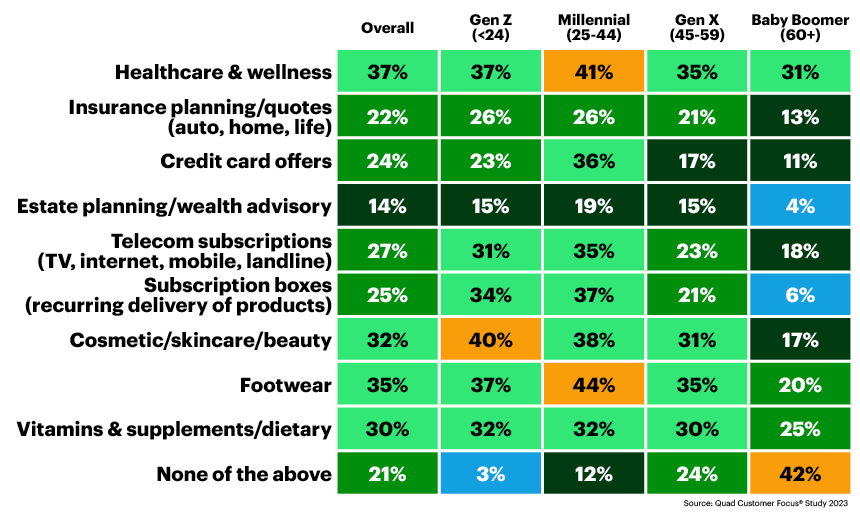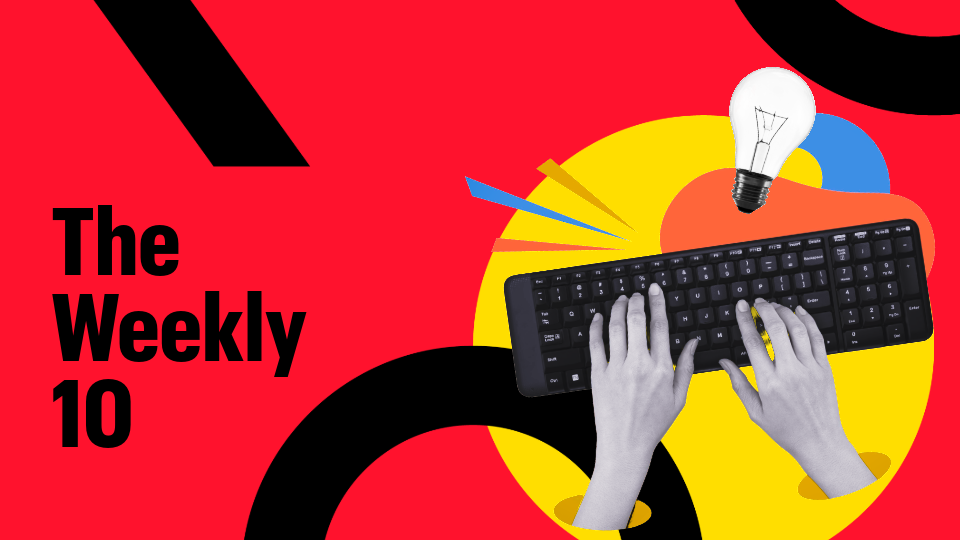Consumers want personalization. They crave being known — especially younger generations. Among 6,000 global consumers surveyed for Twilio's 2023 State of Customer Engagement Report, 66% said they would quit a brand if their experience wasn't personalized. For Gen Z consumers, the number rose to 75%.
By another gauge — willingness to share personal information in exchange for a more personalized shopping experience — younger generations also outranked their elders across a range of goods and service categories, according to research for Quad's 2023 Customer Focus® Study. While all age groups expressed some openness to doing so, Gen Z and Millennials (aka Gen Y) consistently were more willing to share.
For which types of goods or services would you be willing to share data with companies in exchange for a more personalized shopping experience?

Source: Quad Customer Focus® Study 2023
While all generations expressed some degree of appreciation for having personalization follow them from channel to channel, Gen Z, the youngest generation, was again the most enthusiastic.
The Quad research found that 62% of Gen Zers said it was "extremely" or "very" beneficial to have personalization follow them across multiple channels and devices for a seamless shopping experience, compared to:
- 49% of Millennials
- 46% of Gen X
- 45% of Baby Boomers
And research indicates that consumers' appreciation for personalization translates into dollars. In a recent survey by Deloitte, 40% of consumers said they purchased more from brands that personalized engagement, and 37% said they recommended those brands to family and friends. In Twilio's research, consumers said they spend an average of 21% more when brands personalize their experiences.
Bottom line: Brands that aren't optimizing personalization are likely leaving money, brand loyalty and customers' lifetime value on the table.
So are brands all-in on personalization?
Many brands think they are satisfying the desire for personalized experiences, but consumers might disagree. Per the 2023 State of Customer Engagement Report, 46% of brands surveyed reported they were doing an "excellent" job of personalizing customer interactions, but only 15% of consumers said they experienced excellent personalization — a gap 11 points wider than when the study was conducted in 2020.
Deloitte discovered a similar disconnect in its survey of 1,000 U.S. adults and executives at 600 U.S. B-to-C companies in 2022. The executives reported they personalized 56% of customer experiences, but consumers perceived only 38% of their interactions with brands were personalized.
That's a miss for brands. Meaningful personalization even trumps price for many consumers: 38% of consumers told Twilio they would shop a brand they'd had good experiences with again, even if there were less expensive/more convenient options.
On the other hand, personalization that's not truly personalized to a consumer's interests and needs can have the opposite effect. Broad-stroke retargeting can, for example, alienate customers. According to the Deloitte research, more than 50% of consumers said they felt that personalization "tends to feel off-target and doesn't meet their needs, interests or preferences."
Arthur Hall, Senior Director of Research & Insights for Quad, says the effects of imperfectly executed personalization can turn off consumers, hurting brand loyalty and sales.
"Nothing is more annoying than a brand offering you something that is completely outside of the categories you've purchased with that company. If I've bought cross-training apparel and shoes from a brand, I don't want to see, say, hiking gear from them because that's not what I've been buying or am interested in," Hall says. "You have to be hyper-focused on your consumer."
Consumers' expectations on this front are accelerating. In the fifth edition of the State of the Connected Customer report from Salesforce, its global research found that:
- 73% of consumers in 2022 agreed with the statement "I expect companies to understand my unique needs and expectations" — up from 66% in 2020
- 62% said "I expect companies to anticipate my needs" — up from 56% in 2020
- 56% said "I expect offers to always be personalized" — up from 52% in 2020
And a whopping 88% of customers said the experience a company provides is as important as its product or services — up from 80% in 2020.
Then why is there a personalization disconnect?
Two issues fuel the disconnect between brands and consumers on personalization.
First, brands need to think about personalization more broadly. "The challenge for marketers is that there is no one definition of good personalization," Leala Shah Crawford, a managing director for Deloitte Digital, Deloitte Consulting LLP, told The Wall Street Journal's CMO Today. "Instead, it depends on the industry, the company, the brand and the customers as individuals."
Personalization entails so much more than just using an individual's name or sending someone a coupon to use during their birthday month. "You have to identify the right audience and understand their interests, media habits, past transactional activity and more," says Quad's Arthur Hall.
The second issue is the complexity involved in implementing that broader, more effective approach. It requires marketers to pull together new infrastructure surrounding data, analytics, testing, etc.
It can mean breaking down information silos within an organization, and breaking with what's tried and true and is basically working, though it could be working so much better, observes Elizabeth Fowler, a director of analytics for Quad.
"You have to determine what personalization you can do that's meaningful enough to increase response and/or average order value," Fowler says. "Personalization can do that, but only if it's done in a sophisticated way."
Part two of "The personalization disconnect" will dig into these issues and present winning strategies for overcoming the barriers to effective personalization — offering actionable insights on how to incorporate it into offline–plus–online campaigns across multiple touchpoints to close the divide and improve ROI.


